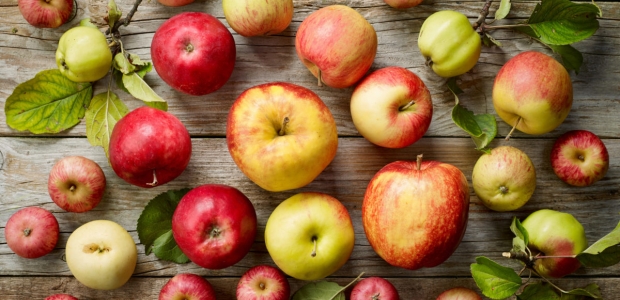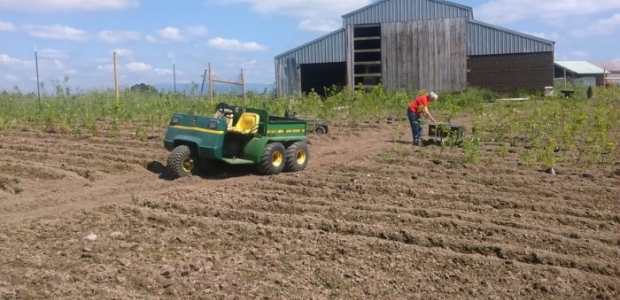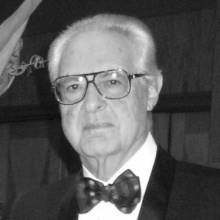Langues
Il giornale dei giornali. Salvate le mele!
4.500 varietà di mele in una collezione privata in Oregon
Lovingly called “our national fruit” by Ralph Waldo Emerson, apples once proliferated in American backyards and orchards, a vital source of nutrition and a potent symbol of home. But now, most of the 15,000 named varieties grown here since 1804 are extinct, and only 15 kinds of apples (think Red Delicious and Gala) now account for 90 percent of U.S. production.
The U.S. Department of Agriculture (USDA) preserves 2,000 international varieties—some of what remains of the diversity of Malus pumila—in Geneva, New York. But, in southwestern Oregon, a 4,500-variety private collection of fruit suited to moderate climates surpasses the government effort.
There, three apple enthusiasts—Joanie Cooper, Shaun Shepherd, and Franki Baccellieri—comprise the full staff of a minuscule nonprofit called the Temperate Orchard Conservancy (TOC). The team is in the midst of cloning each of the varieties in that collection; if they’re successful, says Cooper, TOC’s president and founder, “Those apples will be here for use and for study, long after any of us are dead and gone.”
Possibly as soon as next year, seeds from those trees will also be sent to the Global Seed Vault in Svalbard, where they’ll be preserved, according to the Vault’s mission, to offer “options for future generations to overcome the challenges of climate change and population growth.”
The collection was originally amassed by a man named Nick Botner.
For 30 years, Botner grew an ever-larger selection of heirloom varietals in what eventually became, as he aged and ailed, an over-grown, under-tended orchard. In 2011, he put his property on the market.
The TOC team knew Botner from their mutual affiliation with another apple-related organization. They recognized the adverse repercussions on orchard fruit diversity if his collection was sold and plowed under. Together, and with Botner’s blessing, they started in on what Cooper—a lifelong gardener and apple-identification buff—laughingly calls the “kind of foolish,” monumental task of replicating Botner’s trees.
The Botner collection—with its examples of dessert, cider, and cooking apples—provides a window onto the vibrant history of this fruit and the role it played in American home culture. But it’s also a potential roadmap for the future. For example, says Cooper, “There’s been a burgeoning interest in cider,” which has been insipidly made in the past few decades from cooking apples. “You need bittersweet and other tastes to make a good cider, and we have them all.”
Cloning the Collection
Apples can be grown from seeds, but since each seed yields a tree distinct from its mother, consistency is only assured by grafting a slim branch of the old tree, called a scion, onto a rootstock (a stump with a healthy root system) taken from another apple tree.
Walking Botner’s six-acre orchard back in 2011, Cooper and company began to whittle off scions. They managed to collect about 800 varieties in each the first and second years. These they grafted onto rootstock in a warm, spacious, horticulture-department workroom at Clackamas Community College and placed in one-gallon pots.
In 2012, Cooper sold her house in Portland in order to purchase 40 acres of flat land in Molalla, two hours north of Botner’s place in Yoncalla. And this, Almaty Farm, with room for 15,000 dwarf trees, is where the permanent TOC orchard will reside once the cloned trees are planted. (Almaty means “full of apples” in Kazakh, the language spoken in the region of Kazakhstan where apples originated.)
Heading into winter, 5,000 trees representing some 3,900 of Botner’s varietals have been cloned. However, says Cooper, “Whenever you’re grafting, you also have losses, so one of our jobs this December is to do an inventory and make a list of what we still need to complete.” If all goes well, she thinks that next spring, TOC will be able to graft the last few hundred trees in the Botner collection.
Little by little, the collection has also been expanded with donations from, and trades with, other small orchards around the country—“just one or two, three or four at a time,” says Cooper.
“When we see people who have something we don’t have, we add it. This will be going on ad infinitum.”
Identification, Planting, and Eventually Feeding
After completing the cloning, the TOC’s three members and their devoted handful of volunteers will start moving trees—some of which are currently planted in nursery beds, others of which are stored in pots under shade cloth—into the first two fields of the orchard.
“It’s a little mind-boggling, because you can’t plant them helter-skelter,” says Cooper. “We’ll try to put every apple into a group, deciding if it fits into the Rome group, for example, because of its color, size, basin, cavity. Or flagging summer apples [which ripen in July and August] because you don’t want to walk a 17-acre field trying to find the trees that are ready right now.”
So far, Cooper estimates that she, Shepherd, and Baccellieri have definitively identified about 800 of Botner’s varieties by considering various visual and structural characteristics. They know they’ve got King of Tompkins County, a juicy apple with red cheeks and stripes that hails from New York. And they also have Blue Pearmain, a New England variety from the 1800s that’s covered in a blue haze and offers a crisp bite. Others defy easy classification.
That’s because, for many varieties, “We just have a name, and that means nothing to us,” says Cooper.
“When we are doing ID work, we are usually sitting at a table, surrounded by piles of reference books where we search for descriptions and pictures.” Additionally, TOC has also sent leaves from 69 apples to the USDA’s lab in Colorado for genetic testing. It’s a science in its infancy, with a prohibitively high price tag, which in this instance the USDA performed gratis because it wanted to find varieties it didn’t have in its own collection.
Which is part of the reason TOC is eager to set up its own genetic testing lab at Almaty Farm. Explains Cooper, “It’s a very involved process, but ultimately, to be accurate in identifying the fruit, it’s important to do it. Otherwise, you’re relying on pictures sometimes and descriptions sometimes, but it’s not enough.”
Some heirlooms are more resistant to pests and scab, some are more self-reliant when left untended, and are higher in certain nutritional properties. For these reasons, identifying the varieties and their properties “is an important part of our program,” says Cooper. It’s also one that will require upwards of $200,000 to buy equipment and hire a specialized technician. “What it’ll take,” sighs Cooper, “is a big grant.”
Some of TOC’s future activities are incidental to its main directive to protect diversity. But they’ll provide their own benefits. When asked what will the organization do with all the fruit its trees are certain to soon bear, Cooper’s smile can almost be heard through the phone. “We’ll eventually be hooked up with food banks, and we want to have programs with the Future Farmers of America and 4H, so students can take a block of trees to work and learn on,” she says. “It’ll be such an advantage for our community.”
And when additional scions from TOC’s trees start becoming available for purchase in 2017, helping to re-establish varieties that haven’t existed outside Botner’s small acreage possibly for generations, apple-lovers far and wide will also get to reap the rewards.
Photos within the story by Jafar Jefferson and Franki Baccellieri, respectively.







